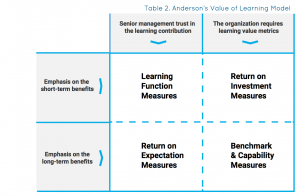Anderson’s Model for Learning Evaluation
This Anderson’s Model for Learning Evaluation is a high levelled evaluation model. Its main use is for organization’s level rather than specific learning interventions. Thus, it aligns the learning function with the organization’s strategic priorities. The two main challenges every organization faces are – the evaluation challenge and the value challenge. The organization says they struggle to the evaluations well. Also, the main struggle is to find the evidence that their training works. The Anderson’s Model for Learning Evaluation has three stage cycles to address the value challenge and evaluation.
The three cycles are:
- Determine current alignment against strategic priorities. The very first stage questions: if the company’s goal is towards the sale driving, then the training accent that? Is the training in line with the strategy?
- Use a range of methods to assess and evaluate the contribution of learning. This second stage outlines the four areas of evaluation: Return on expectation measures, Return on investment measures, Learning function measures, and the Benchmark and capacity measures.
- Establish the most relevant approaches for your organization. The final stage.
The most difficult challenge in this model is data collection. This determines where the organization falls in each of the three stages. Because whenever this question arises of data collection the answers always is “it’s difficult.” This is a wonderful model. Therefore to make it more useful, one needs to solve the data collection issue.
For certification in the L&D visit –


